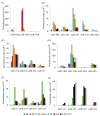Differential expression patterns of conserved miRNAs and isomiRs during Atlantic halibut development
- PMID: 22233483
- PMCID: PMC3398304
- DOI: 10.1186/1471-2164-13-11
Differential expression patterns of conserved miRNAs and isomiRs during Atlantic halibut development
Abstract
Background: MicroRNAs (miRNAs) play a major role in animal ontogenesis. Size variants of miRNAs, isomiRs, are observed along with the main miRNA types, but their origin and possible biological role are uncovered yet. Developmental profiles of miRNAs have been reported in few fish species only and, to our knowledge, differential expressions of isomiRs have not yet been shown during fish development. Atlantic halibut, Hippoglossus hippoglossus L., undergoes dramatic metamorphosis during early development from symmetrical pelagic larval stage to unsymmetrical flatfish. No data exist on role of miRNAs in halibut metamorphosis.
Results: miRNA profiling using SOLiD deep sequencing technology revealed a total of 199 conserved, one novel antisense, and one miRNA* mature form. Digital expression profiles of selected miRNAs were validated using reverse transcription quantitative PCR. We found developmental transition-specific miRNA expression. Expression of some miRNA* exceeded the guide strand miRNA. We revealed that nucleotide truncations and/or additions at the 3' end of mature miRNAs resulted in size variants showing differential expression patterns during the development in a number of miRNA families. We confirmed the presence of isomiRs by cloning and Sanger sequencing. Also, we found inverse relationship between expression levels of sense/antisense miRNAs during halibut development.
Conclusion: Developmental transitions during early development of Atlantic halibut are associated with expression of certain miRNA types. IsomiRs are abundant and often show differential expression during the development.
Figures







Similar articles
-
Characterization of novel precursor miRNAs using next generation sequencing and prediction of miRNA targets in Atlantic halibut.PLoS One. 2013 Apr 23;8(4):e61378. doi: 10.1371/journal.pone.0061378. Print 2013. PLoS One. 2013. PMID: 23626677 Free PMC article.
-
Identification and differential expression of microRNAs during metamorphosis of the Japanese flounder (Paralichthys olivaceus).PLoS One. 2011;6(7):e22957. doi: 10.1371/journal.pone.0022957. Epub 2011 Jul 27. PLoS One. 2011. PMID: 21818405 Free PMC article.
-
Sex-biased miRNA expression in Atlantic halibut (Hippoglossus hippoglossus) brain and gonads.Sex Dev. 2012;6(5):257-66. doi: 10.1159/000341378. Epub 2012 Jul 26. Sex Dev. 2012. PMID: 22846363
-
Thyroid hormone receptor expression during metamorphosis of Atlantic halibut (Hippoglossus hippoglossus).Mol Cell Endocrinol. 2008 Jan 16;281(1-2):56-63. doi: 10.1016/j.mce.2007.10.009. Epub 2007 Oct 24. Mol Cell Endocrinol. 2008. PMID: 18068891
-
Comparative sequence analysis of the complete set of 40S ribosomal proteins in the Senegalese sole (Solea senegalensis Kaup) and Atlantic halibut (Hippoglossus hippoglossus L.) (Teleostei: Pleuronectiformes): phylogeny and tissue- and development-specific expression.BMC Evol Biol. 2007 Jul 3;7:107. doi: 10.1186/1471-2148-7-107. BMC Evol Biol. 2007. PMID: 17608926 Free PMC article.
Cited by
-
Inventory of European Sea Bass (Dicentrarchus labrax) sncRNAs Vital During Early Teleost Development.Front Genet. 2019 Jul 25;10:657. doi: 10.3389/fgene.2019.00657. eCollection 2019. Front Genet. 2019. PMID: 31404269 Free PMC article.
-
Evolution of Fish Let-7 MicroRNAs and Their Expression Correlated to Growth Development in Blunt Snout Bream.Int J Mol Sci. 2017 Mar 16;18(3):646. doi: 10.3390/ijms18030646. Int J Mol Sci. 2017. PMID: 28300776 Free PMC article.
-
A combined strategy involving Sanger and 454 pyrosequencing increases genomic resources to aid in the management of reproduction, disease control and genetic selection in the turbot (Scophthalmus maximus).BMC Genomics. 2013 Mar 15;14:180. doi: 10.1186/1471-2164-14-180. BMC Genomics. 2013. PMID: 23497389 Free PMC article.
-
Dynamic Expression and Gene Regulation of MicroRNAs During Bighead Carp (Hypophthalmichthys nobilis) Early Development.Front Genet. 2022 Jan 19;12:821403. doi: 10.3389/fgene.2021.821403. eCollection 2021. Front Genet. 2022. PMID: 35126475 Free PMC article.
-
Temperature during early development has long-term effects on microRNA expression in Atlantic cod.BMC Genomics. 2015 Apr 17;16(1):305. doi: 10.1186/s12864-015-1503-7. BMC Genomics. 2015. PMID: 25881242 Free PMC article.
References
-
- Sæle Ø, Solbakken JS, Watanabe K, Hamre K, Power D, Pittman K. Staging of Atlantic halibut (Hippoglossus hippoglossus L.) from first feeding through metamorphosis, including cranial ossification independent of eye migration. Aquaculture. 2004;239(1-4):445–465.
-
- Pittman K, Skiftesvik A, Berg L. Morphological and behavioural development of halibut, Hippoglossus hippoglossus (L.) larvae. J Fish Biol. 1990;37(3):455–472.
-
- Wightman B, Ha I, Ruvkun G. Posttranscriptional regulation of the heterochronic gene Lin-14 by Lin-4 mediates temporal pattern-formation in C. elegans. Cell. 1993;75(5):855–862. - PubMed
-
- Lee RC, Feinbaum RL, Ambros V. The C. elegans heterochronic gene lin-4 encodes small RNAs with antisense complementarity to lin-14. Cell. 1993;75(5):843–854. - PubMed
-
- Wienholds E, Plasterk RHA. MicroRNA function in animal development. FEBS Lett. 2005;579(26):5911–5922. - PubMed
Publication types
MeSH terms
Substances
LinkOut - more resources
Full Text Sources
Other Literature Sources

